Backwaters of Kerala
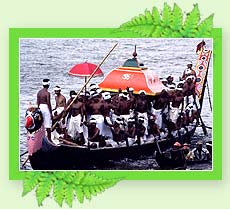 Kerala Backwaters :
Kerala Backwaters :Kerala's backwaters is the most popular tourist attraction of Kerala. The palm-fringed, tranquil backwaters were once just the state's trade highways. Kerala is her backwaters and lakes. They have dictated her history, shaped her present and promise a future by virtue of offering incomparable beauty and unique experiences.
The state's palm-fringed backwaters are inland lakes connected by a network of canals. With 41 west-flowing rivers, the backwaters stretch to almost 1,900 kilometers. The backwater routes date back over the centuries and have been long used for all transportation needs, in particular trade in coconut, rubber, rice and spices. Today, these waterways link remote villages and islands to the mainland and nerve centers of the coastal area.
The most interesting area in the backwaters is the Kuttanad region, called the rice bowl of Kerala. The area is probably the only place in the continent where farming is done below sea level, using a system of dykes and bunds.
The largest backwater stretch is the Vembanad Lake, which opens out into the sea at the Kochi port and flows through three districts-Alappuzha, Kottayam and Kochi. The Ashtamudi Lake has eight 'arms' covering a major portion of Kollam district in the south, and is the second largest lake in the state.
Alappuzha is one of the major centers for backwater boat trips. The intricate network of canals through this town has earned it the sobriquet "The Venice of the East". Small but long country boats are the taxies of the water. The coir workers present an interesting sight as they soak coconut fiber in pools, beat them and wind the strands on long spindles stretched between an endless lines of coconut trees.
A short distance from Thiruvananthapuram is the Veli Aakulam lagoon. Water sports, a floating restaurant, an amusement park, speedboats and other facilities make this spot a tourist attraction. The east end of the lake is flanked by two scenic hillocks.
The charming old port city of Kollam on the banks of the Ashtamudi Lake is known as the center of the cashew industry. It is one of the oldest ports of the backwaters, with the ferry to Alappuzha taking more than 8 hours. A small village 12 kilometer west of Kottayam town, on the banks of the beautiful Vembanad Lake, Kumarakom is 14-acre bird sanctuary known for local varieties of water fowl, cuckoo, water ducks, and migrating Siberian storks. The best months to visit it are June-August. Just 80 kilometres from Cochin, this area has unique kettuvalloms (houseboats), boat racing, motorboat and water sport facilities. The houseboats, plied by local oarsmen, are simply furnished with a living room, bedroom with attached bath and a raised central deck for lazing on cushions while watching the world go by.
In north Kerala, the cool backwaters of Kozhikode lie waiting to be explored. This old commercial town attracts travelers for its history, wonderful backwaters and leisure sports.
Alumkadavu, in the town of Karunagapally hardly 20 kilometers north of Kollam, is where kettuvalloms are built. These huge, long and tapering barges were traditionally used to carry tones of goods, with a portion covered with bamboo and coir servicing as a rest room and kitchen for the crew. Gliding down the calm and serene backwaters in a kettuvallom, embraced by green leaves and palm, see a rural Kerala preserved through the ages, completely hidden from the road, and it is not surprising that this is called God's Own Country.
Famous for its natural harbor, one of the best in the world, Kochi has earned the sobriquet "Queen of the Arabian Sea". All the islands that make up Kochi are well connected by ferry. The Chinese fishing nets, a method of fishing established in Kochi during the times of Kubla Khan line the waterfront.
Besides these backwaters, other equally beautiful water bodies elsewhere are Veli (in South Kerala), Kadinamkulam, Edava, Anjengo, Madayara, Peravur, Ashtamudi, Kayamkulam, Kodungalur, Chetuva and Valiyaparamba (in North Kerala).
In the monsoon months, the backwaters reverberate with the sound of the traditional snake boat races, featuring the 130-feet-long chundan boats. Up to 16 of them, with over a hundred rowers each, compete for the honors during the races. The most important of these races is the Nehru Trophy Boat Race held on the second Saturday of August. The Aranmula Boat Festival of the Parthasarathy temple of Aranmula on the banks of the holy river Pamba is the more traditional race. The boat carnival starts on the day of Thiruonam, the most auspicious day of the Kerala festival, Onam.
Whether by Kettuvalloms or by a simple vallom, the experience of gliding through the backwaters is an experience that is undeniably unforgettable.
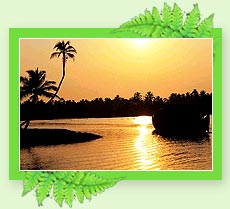
Alleppey Backwaters :

Alleppey (Alappuzha) is prominent on the tourist trail as it is one of the major centers for backwater boat trips. With Arabian sea on the west, Alappuzha has a large network of lakes, lagoons and several freshwater rivers intersections. Alappuzha has grown in importance as a backwater tourist center, attracting several thousands of foreign tourists every year who come here to enjoy the serene marine beauty of the state. Boat races, houseboat holidays, beaches, marine products and coir industry are some of the major attractions offered by Alappuzha.
Unique attractions of Alappuzha are:
Water Sports - Tourists can participate in numerous beach activities offered on the beautiful Alappuzha beach. For instance, you could indulge in any of the exciting water sports such as surfing or parasailing, or go swimming in the clear blue sea, or even try your hand at building a sand castle or playing a game of beach volleyball.
Boat Races - It is held in the months of August and September when the earth is moist and rain-drenched and the glorious backwaters overflows. Hundreds of men and women gather on the banks to witness a spectacular view especially, the Snake Boat Races.
The most famous event of boat race is the "Nehru Trophy Boat Race". It is held on the second saturday of every August. There are a dozen other snake boat races, providing an unforgettable and truly special scene. The fund of energy, spirit of competition and unerring co-ordination makes this sport extremely dynamic.
A short distance from Thiruvananthapuram is the Veli Aakulam lagoon. Water sports, a floating restaurant, an amusement park, speedboats and other facilities make this spot a tourist attraction. The east end of the lake is flanked by two scenic hillocks.
The charming old port city of Kollam on the banks of the Ashtamudi Lake is known as the center of the cashew industry. It is one of the oldest ports of the backwaters, with the ferry to Alappuzha taking more than 8 hours. A small village 12 kilometer west of Kottayam town, on the banks of the beautiful Vembanad Lake, Kumarakom is 14-acre bird sanctuary known for local varieties of water fowl, cuckoo, water ducks, and migrating Siberian storks. The best months to visit it are June-August. Just 80 kilometres from Cochin, this area has unique kettuvalloms (houseboats), boat racing, motorboat and water sport facilities. The houseboats, plied by local oarsmen, are simply furnished with a living room, bedroom with attached bath and a raised central deck for lazing on cushions while watching the world go by.
In north Kerala, the cool backwaters of Kozhikode lie waiting to be explored. This old commercial town attracts travelers for its history, wonderful backwaters and leisure sports.
Alumkadavu, in the town of Karunagapally hardly 20 kilometers north of Kollam, is where kettuvalloms are built. These huge, long and tapering barges were traditionally used to carry tones of goods, with a portion covered with bamboo and coir servicing as a rest room and kitchen for the crew. Gliding down the calm and serene backwaters in a kettuvallom, embraced by green leaves and palm, see a rural Kerala preserved through the ages, completely hidden from the road, and it is not surprising that this is called God's Own Country.
Famous for its natural harbor, one of the best in the world, Kochi has earned the sobriquet "Queen of the Arabian Sea". All the islands that make up Kochi are well connected by ferry. The Chinese fishing nets, a method of fishing established in Kochi during the times of Kubla Khan line the waterfront.
Besides these backwaters, other equally beautiful water bodies elsewhere are Veli (in South Kerala), Kadinamkulam, Edava, Anjengo, Madayara, Peravur, Ashtamudi, Kayamkulam, Kodungalur, Chetuva and Valiyaparamba (in North Kerala).
In the monsoon months, the backwaters reverberate with the sound of the traditional snake boat races, featuring the 130-feet-long chundan boats. Up to 16 of them, with over a hundred rowers each, compete for the honors during the races. The most important of these races is the Nehru Trophy Boat Race held on the second Saturday of August. The Aranmula Boat Festival of the Parthasarathy temple of Aranmula on the banks of the holy river Pamba is the more traditional race. The boat carnival starts on the day of Thiruonam, the most auspicious day of the Kerala festival, Onam.
Whether by Kettuvalloms or by a simple vallom, the experience of gliding through the backwaters is an experience that is undeniably unforgettable.

Alleppey Backwaters :
Alleppey (Alappuzha) is prominent on the tourist trail as it is one of the major centers for backwater boat trips. With Arabian sea on the west, Alappuzha has a large network of lakes, lagoons and several freshwater rivers intersections. Alappuzha has grown in importance as a backwater tourist center, attracting several thousands of foreign tourists every year who come here to enjoy the serene marine beauty of the state. Boat races, houseboat holidays, beaches, marine products and coir industry are some of the major attractions offered by Alappuzha.
Unique attractions of Alappuzha are:
Water Sports - Tourists can participate in numerous beach activities offered on the beautiful Alappuzha beach. For instance, you could indulge in any of the exciting water sports such as surfing or parasailing, or go swimming in the clear blue sea, or even try your hand at building a sand castle or playing a game of beach volleyball.
Boat Races - It is held in the months of August and September when the earth is moist and rain-drenched and the glorious backwaters overflows. Hundreds of men and women gather on the banks to witness a spectacular view especially, the Snake Boat Races.
The most famous event of boat race is the "Nehru Trophy Boat Race". It is held on the second saturday of every August. There are a dozen other snake boat races, providing an unforgettable and truly special scene. The fund of energy, spirit of competition and unerring co-ordination makes this sport extremely dynamic.
Travel attractions of Alleppey are:
Kuttanad - Kuttanad, called the rice bowl of Kerala, because of her wealth of paddy crops is at the very heart of the backwaters. The scenic countryside of Kuttanad with its shimmering waterways also has a rich crop of bananas.
Krishnapuram Palace - The 18th century Krishnapuram Palace built during the reign of the Travancore monarch, Marthanda Varma, is a double storied structure which displays typical characteristics of Kerala architecture-gabled roofs, dormer windows, narrow corridors.
Ambalappuzha (Pilgrim Center) - The Sri Krishna Temple at Ambalapuzha, 14 kms from Alleppey is among Kerala's more famous ones boasting of the typical temple architectural style of the state.
Pathiramanal - 14 kilometers from Alleppy, this little island on the backwaters is a favorite haunt of hundreds of rare migratory birds from different parts of the world.
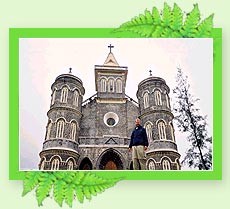 Kochi Backwaters :
Kochi Backwaters :

Known as Queen of the Arabian Sea, Cochin (Kochi) is believed to be the finest natural harbour in the world. It is a cluster of islands on the vast expanse of the Vembanad Lake. Because of its commercial importance, foreign powers vied for supremacy in the area and therefore the place has a blend of several exotic cultures like the Portuguese, Jewish, English, French, Dutch and Chinese.
Ferry rides in Kochi commands a breathtaking view due to its lush green lawns sloping down to the water's edge. Giant Chinese fishing nets that billow from massive teak and bamboo poles dot the entrance to the harbor. Silhouetted against the setting sun, they present a magnificent sight at the waterfront.
Houseboats are a unique way to experience the beauty of Cochin. The houseboats glide on the backwaters of Kochi, with panoramic view passing by.
Major tourist attractions are:
Bolghatty Island - Bolghatty palace, built by the Dutch in 1744 for their governors and later used by the British governors is situated here. Today it is a Kerala Tourism Development Corporation (KTDC) owned hotel.
Willington Island - This is situated in the backwaters and is named after the British viceroy to India, Lord Willington. The headquarters of the naval command, port trust, trading centers etc are located here.
Fort Kochi - A fishing village, Fort Kochi became a European trading center in the middle ages.
Mattancherry Palace (Dutch Palace) - This was built by some foreigners on Hindu architectural style in 1555.
St Francis Church - Built of wood in 1503, it may be the oldest European church in India. Vasco-da-Gama was buried here.
Kuttanad - Kuttanad, called the rice bowl of Kerala, because of her wealth of paddy crops is at the very heart of the backwaters. The scenic countryside of Kuttanad with its shimmering waterways also has a rich crop of bananas.
Krishnapuram Palace - The 18th century Krishnapuram Palace built during the reign of the Travancore monarch, Marthanda Varma, is a double storied structure which displays typical characteristics of Kerala architecture-gabled roofs, dormer windows, narrow corridors.
Ambalappuzha (Pilgrim Center) - The Sri Krishna Temple at Ambalapuzha, 14 kms from Alleppey is among Kerala's more famous ones boasting of the typical temple architectural style of the state.
Pathiramanal - 14 kilometers from Alleppy, this little island on the backwaters is a favorite haunt of hundreds of rare migratory birds from different parts of the world.
 Kochi Backwaters :
Kochi Backwaters :Known as Queen of the Arabian Sea, Cochin (Kochi) is believed to be the finest natural harbour in the world. It is a cluster of islands on the vast expanse of the Vembanad Lake. Because of its commercial importance, foreign powers vied for supremacy in the area and therefore the place has a blend of several exotic cultures like the Portuguese, Jewish, English, French, Dutch and Chinese.
Ferry rides in Kochi commands a breathtaking view due to its lush green lawns sloping down to the water's edge. Giant Chinese fishing nets that billow from massive teak and bamboo poles dot the entrance to the harbor. Silhouetted against the setting sun, they present a magnificent sight at the waterfront.
Houseboats are a unique way to experience the beauty of Cochin. The houseboats glide on the backwaters of Kochi, with panoramic view passing by.
Major tourist attractions are:
Bolghatty Island - Bolghatty palace, built by the Dutch in 1744 for their governors and later used by the British governors is situated here. Today it is a Kerala Tourism Development Corporation (KTDC) owned hotel.
Willington Island - This is situated in the backwaters and is named after the British viceroy to India, Lord Willington. The headquarters of the naval command, port trust, trading centers etc are located here.
Fort Kochi - A fishing village, Fort Kochi became a European trading center in the middle ages.
Mattancherry Palace (Dutch Palace) - This was built by some foreigners on Hindu architectural style in 1555.
St Francis Church - Built of wood in 1503, it may be the oldest European church in India. Vasco-da-Gama was buried here.
Kollam Backwaters :

Known as the entry and exit point of the backwaters of Kerala, Kollam is situated 71 km to the north of Thiruvananthapuram. It is one of the oldest ports of the Malabar coast and was once the center of international spice trade, especially known for its marine and cashew industries. It is also the largest producer of cashew in the state.
30% of Kollam (Quilon) is covered by the renowned Ashtamudi lake and the eight-hour boat trip between Kollam and Alappuzha is the longest and most enchanting experience on the backwaters of Kerala. Kollam (Quilon) architectural remnants and a number of temples built in the traditional ornate style are the witness of the enchanting history of this town.
Tourist can visit Mata Amritanandamayi Ashram, a spiritual trust in India with a large number of educational, technical and health care industries is headquartered at Vallikkavu, near Kollam. The Picnic Village located at Ashramam, along the backwater front, is the main center of recreational activities in Kollam. A 200-year-old Government Guest House, an Adventure Park, a Tourist Boat Club, a Children's Traffic Park and a Yatri Nivas are all housed in this vast tourist complex.
The ancient Sastha temple, which lends its name to the town, is an important pilgrim center. Mayyanad, 10 kms off south to Kollam town, is famous for her shrines and temples. The most important of the nine temples here is the Subramanya Temple at Umayanallor. Thangasseri, a seaside village five kms away from the town is of great historic importance with the remnants of the old Portuguese fort and church.
Oachira is noted for its Parabrahma temple where no deity or idol is consecrated, but is dedicated to the universal and transcendental consciousness. The Alaruvi waterfalls, 75 kms from Kollam town, make its way down the rocks from a height of 300 feet. The Palaruvi woods is a beautiful picnic spot.
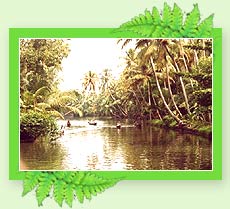
Kumarakom Backwaters :

Kumarakom is situated 15 km from Kottayam, on National Highway (NH) 47 between Thiruvananthapuram (Trivandrum) and Kochi (Cochin). Kumarakom is a cluster of little islands located on the banks of the famous Vembanad Lake. The Vembanad Lake displys an intricate and enchantingly beautiful web of majestic canals, streams and distributaries. The gorgeous green of the fringed palms beautifully contrast with the ripple in the blue waters. The water ways of Kumarakom is now a big attraction for tourist.
It is incredibly different experience to cruise in Kumarakom backwater in a country boat, experiencing the beauty of Kerala villages. The bird sanctuary here, which is spread across 14 acres is a favorite haunt of migratory birds and an ornithologist's paradise. Egrets, darters, herons, teal, waterfowl, cuckoo, wild duck and migratory birds like the Siberian stork that live There in flocks are a fascination for visitors. The best way to watch the birds of the Kumarakom sanctuary is a boat trip round the islands.
An enchanting backwater destination, Kumarakom offers visitors many other leisure options. Boating and fishing facilities are available at Kumarakom. Holiday packages on the houseboats, traditional Kettuvalloms, are an out-of-this-world experience at Kumarakom. Millions of green coconut palms are lined on the river side, leaning to touch its reflections on the glassy waters. Blooming flowers, multi-hued birds, succulent freshwater fishes, all these makes the nature perfect at Kumarakom.
Known as the entry and exit point of the backwaters of Kerala, Kollam is situated 71 km to the north of Thiruvananthapuram. It is one of the oldest ports of the Malabar coast and was once the center of international spice trade, especially known for its marine and cashew industries. It is also the largest producer of cashew in the state.
30% of Kollam (Quilon) is covered by the renowned Ashtamudi lake and the eight-hour boat trip between Kollam and Alappuzha is the longest and most enchanting experience on the backwaters of Kerala. Kollam (Quilon) architectural remnants and a number of temples built in the traditional ornate style are the witness of the enchanting history of this town.
Tourist can visit Mata Amritanandamayi Ashram, a spiritual trust in India with a large number of educational, technical and health care industries is headquartered at Vallikkavu, near Kollam. The Picnic Village located at Ashramam, along the backwater front, is the main center of recreational activities in Kollam. A 200-year-old Government Guest House, an Adventure Park, a Tourist Boat Club, a Children's Traffic Park and a Yatri Nivas are all housed in this vast tourist complex.
The ancient Sastha temple, which lends its name to the town, is an important pilgrim center. Mayyanad, 10 kms off south to Kollam town, is famous for her shrines and temples. The most important of the nine temples here is the Subramanya Temple at Umayanallor. Thangasseri, a seaside village five kms away from the town is of great historic importance with the remnants of the old Portuguese fort and church.
Oachira is noted for its Parabrahma temple where no deity or idol is consecrated, but is dedicated to the universal and transcendental consciousness. The Alaruvi waterfalls, 75 kms from Kollam town, make its way down the rocks from a height of 300 feet. The Palaruvi woods is a beautiful picnic spot.

Kumarakom Backwaters :
Kumarakom is situated 15 km from Kottayam, on National Highway (NH) 47 between Thiruvananthapuram (Trivandrum) and Kochi (Cochin). Kumarakom is a cluster of little islands located on the banks of the famous Vembanad Lake. The Vembanad Lake displys an intricate and enchantingly beautiful web of majestic canals, streams and distributaries. The gorgeous green of the fringed palms beautifully contrast with the ripple in the blue waters. The water ways of Kumarakom is now a big attraction for tourist.
It is incredibly different experience to cruise in Kumarakom backwater in a country boat, experiencing the beauty of Kerala villages. The bird sanctuary here, which is spread across 14 acres is a favorite haunt of migratory birds and an ornithologist's paradise. Egrets, darters, herons, teal, waterfowl, cuckoo, wild duck and migratory birds like the Siberian stork that live There in flocks are a fascination for visitors. The best way to watch the birds of the Kumarakom sanctuary is a boat trip round the islands.
An enchanting backwater destination, Kumarakom offers visitors many other leisure options. Boating and fishing facilities are available at Kumarakom. Holiday packages on the houseboats, traditional Kettuvalloms, are an out-of-this-world experience at Kumarakom. Millions of green coconut palms are lined on the river side, leaning to touch its reflections on the glassy waters. Blooming flowers, multi-hued birds, succulent freshwater fishes, all these makes the nature perfect at Kumarakom.
Trivandrum Backwaters :

The extensive backwaters of Trivandrum provide the picturesque view of a paradise. The intricate lagoons, lakes, canals and rivers are lined up along the dense tropical vegetation of Trivandrum. It is a breathtaking bout to experience a solitary and calm glide through this network of waterways. The backwaters form a specially attractive and economically valuable feature of Kerala. The biggest backwater is the Vembabad lake, some 200 sq kilometers in area, which opens out into the Arabian Sea at Cochin port.
The serene backwater stretch, en-route to Kovalam, is famous for its canoe rides. It is the meeting point of two rivers-Killi and Karamana. A temple dedicated to Parashurama, the legendary founder of Kerala, is located in Thiruvallam.
Few attractions of Trivandrum backwaters are:
Padmanabhaswamy temple - The most impressive landmark in the town, the temple's presiding deity is Vishnu reclining on serpent Anantha. It has a seven-story tower, umpteen number of pillars, intricate carvings and mural paintings.
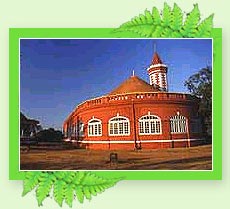 Museum complex - Art and natural history museums, art gallery and zoological and botanical gardens are located in a plot in the heart of the city. The museum contains paintings and other collections of the royal family.
Museum complex - Art and natural history museums, art gallery and zoological and botanical gardens are located in a plot in the heart of the city. The museum contains paintings and other collections of the royal family.
Kanakakkunnu Palace - Today it is a venue for cultural and other public functions.
Science & Technology museum - Located near Mascot hotel, it is a valuable site for students and researchers.
Sanghumugham beach - A favorite haunt of sunset watchers. A gigantic 35 m sculpture of a mermaid, called Matsya Kanyaka, is a major attraction here. There is facility for recreational activities. The place is near the airport and the Veli tourist village.
Veli tourist village - An ideal picnic spot where the lake joins the sea. Boating facility is available in the lake. A popular retreat, it has a children's park and other attractions.
Neyyar dam - It is a popular picnic spot and has a watchtower, crocodile farm, lion safari park and a deer park, Aruvikkara dam, a picturesque picnic spot on the banks of Karamana river.
The extensive backwaters of Trivandrum provide the picturesque view of a paradise. The intricate lagoons, lakes, canals and rivers are lined up along the dense tropical vegetation of Trivandrum. It is a breathtaking bout to experience a solitary and calm glide through this network of waterways. The backwaters form a specially attractive and economically valuable feature of Kerala. The biggest backwater is the Vembabad lake, some 200 sq kilometers in area, which opens out into the Arabian Sea at Cochin port.
The serene backwater stretch, en-route to Kovalam, is famous for its canoe rides. It is the meeting point of two rivers-Killi and Karamana. A temple dedicated to Parashurama, the legendary founder of Kerala, is located in Thiruvallam.
Few attractions of Trivandrum backwaters are:
Padmanabhaswamy temple - The most impressive landmark in the town, the temple's presiding deity is Vishnu reclining on serpent Anantha. It has a seven-story tower, umpteen number of pillars, intricate carvings and mural paintings.
 Museum complex - Art and natural history museums, art gallery and zoological and botanical gardens are located in a plot in the heart of the city. The museum contains paintings and other collections of the royal family.
Museum complex - Art and natural history museums, art gallery and zoological and botanical gardens are located in a plot in the heart of the city. The museum contains paintings and other collections of the royal family.Kanakakkunnu Palace - Today it is a venue for cultural and other public functions.
Science & Technology museum - Located near Mascot hotel, it is a valuable site for students and researchers.
Sanghumugham beach - A favorite haunt of sunset watchers. A gigantic 35 m sculpture of a mermaid, called Matsya Kanyaka, is a major attraction here. There is facility for recreational activities. The place is near the airport and the Veli tourist village.
Veli tourist village - An ideal picnic spot where the lake joins the sea. Boating facility is available in the lake. A popular retreat, it has a children's park and other attractions.
Neyyar dam - It is a popular picnic spot and has a watchtower, crocodile farm, lion safari park and a deer park, Aruvikkara dam, a picturesque picnic spot on the banks of Karamana river.
No comments:
Post a Comment